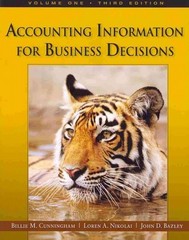Question
1. Significant risk often relates to A. lowdollarvalue transactions. B. routine transactions. C. simple transactions. D. nonroutine transactions. 2. The possibility that fraud has resulted
1. Significant risk often relates to
A. lowdollarvalue transactions.
B. routine transactions.
C. simple transactions.
D. nonroutine transactions.
2. The possibility that fraud has resulted in intentional misstatement in the financial statements is known as
A. fraud risk.
B. control risk.
C. detection risk.
D. acceptable audit risk.
3. Three conditions for fraud are referred to as the"fraud triangle." One of the sides of this triangle is incentives or pressures. The other two sides are
A. opportunities and a desire to meet debt repayment obligations.
B. attitudes or rationalizations and the need to maintain stock prices.
C. the need to maintain stock prices and the need to meet debt repayment obligations.
D. opportunities and attitudes or rationalizations.
4. Fraud risk factors are examples of factors that increase the risk of fraud. Which of the following is an example of a management"incentives orpressures" riskfactor?
A. There is only one board member who understands financial statements and she has suffered a heart attack.
B. There has been significant turnover in the accounting department in the last year.
C. Customer demand for a new product line was significantly less than expected.
D. Management and the auditors disagree on how to value a large contract in progress.
5. Which of the following is a factor that relates to"attitudes orrationalization" to commit fraudulent financialreporting?
A. significant accounting estimates involving subjective judgments
B. high turnover ofaccounting, internalaudit, and information technology staff
C. management's practice of making overly aggressive forecasts
D. excessive pressure for management to meet debt repayment requirements
6. Senior managers of Mega Corp. are entitled to receive large bonuses if they achieve earnings targets. What is the effect of this on the risks associated with recording ofrevenue?
A. It decreases fraud risks associated with revenue.
B. It increases fraud risks associated with revenue.
C. It increases detection risks associated with revenue.
D. It decreases control risks associated with revenue.
7. What audit procedure would be anauditor's response to address management override of controls?
A. Evaluate systematic processing of large volumes of daytoday ordinary transactions.
B. Evaluate in detail payroll transactions.
C. Evaluate business rationale for significant unusual transactions.
D. Evaluate possibilities of petty cash embezzlements.
8. Acceptable audit risk is a measure of
A. theauditor's assessment of the likelihood that a material misstatement might occur in the first place.
B. how willing the auditor is to accept that the financial statements may be materially misstated after the audit is completed.
C. the probability that the financial statements contain errors.
D. the probability that errors in the financial statements that were not detected by the internal controls of the firm are not detected by the auditor.
9. If the auditor assessed the detection risk ashigh, the extent of evidence the auditor plans to accumulate is
A. high.
B. medium.
C. low.
D. uncertain: more information is needed.
10. PA has set acceptable audit risk at5% and determined that inherent risk and control risk is at100%. What is the detectionrisk?
A. 20%
B. 50%
C. 95%
D. 5%
11. Which of the following describes the components of the audit risk model that are used to describe the risk of material misstatement(RMM)?
A. AAR/ DR
B. IR DR
C. CR DR
D. IR CR
12. What is the role of internal controls during the assessment of inherentrisk?
A. There is a direct relationship between the quality of internal controls and inherent risk.
B. As the quality of internal controlsimproves, inherent risk increases.
C. Internal controls are consideredseparately, so they are ignored during the assessment of inherent risk.
D. As the quality of internal controlsincreases, inherent risk decreases.
13. Assessing design effectiveness and conducting tests of controls are required when the auditor
A. chooses to set control risk below 100 percent and relies on the controls.
B. chooses to set control risk below 100 percent even if there is no reliance placed on controls.
C. tests the design effectiveness.
D. is planning the audit.
14. As the effectiveness of internal controlincreases, what happens to controlrisk?
A. It stays the same.
B. It decreases.
C. It increases.
D. It changes based on the audit procedures conducted.
Step by Step Solution
There are 3 Steps involved in it
Step: 1

Get Instant Access to Expert-Tailored Solutions
See step-by-step solutions with expert insights and AI powered tools for academic success
Step: 2

Step: 3

Ace Your Homework with AI
Get the answers you need in no time with our AI-driven, step-by-step assistance
Get Started


